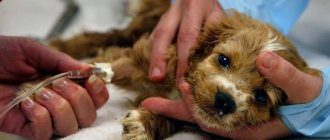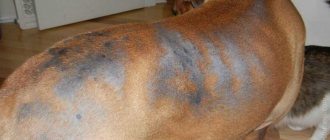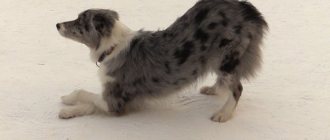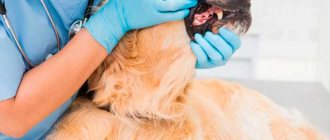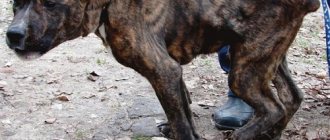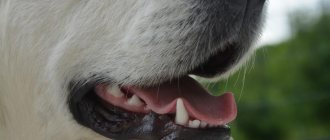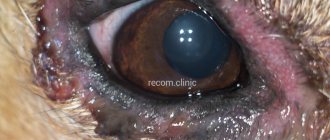Causes
The main causes of gastric volvulus are considered to be the dog’s genetic predisposition to pathology and its size. A complex of reasons (sudden movement, stretching or rupture of the gastric ligaments) causes torsion of the stomach in the direction from right to left and from back to front, resulting in compression of the cardiac sphincter and esophagus.
List and explanation of the main causes of gastric volvulus syndrome.
Ignorance of the principles of nutrition and exercise
The owner’s mistake is to feed the pet before a walk, a large portion at a time, lack of split meals (2-3 times a day), swallowing air (a hungry dog greedily swallows food along with air). A malfunction of the nervous system provokes the accumulation of air in the stomach, and with active, sudden movements, a strong displacement of the organ occurs, followed by twisting.
In fact, gastric volvulus can be compared to a balloon pulled tightly on both sides, the only difference being that there are two strings, and physiologically it is necessary to constantly empty the stomach of food mass and air. When this does not happen, signs of an acute condition arise, threatening rupture of the walls, peritonitis and death.
Diet
The gastrointestinal tract occupies a large area in the abdominal cavity. Up to 70% of the gases necessary for the normal functioning of the stomach and intestines are swallowed with food. Normally, air comes out with belching, is absorbed or exits through the anal sphincter.
Foods with increased gas formation (fiber, legumes, cabbage, brown bread, potatoes, etc.) increase the amount of gases, as a result, the swollen stomach ball can twist under certain circumstances.
It must be remembered that a dog is a carnivore, and the majority of the diet should be meat (approximately 80%), and not porridge or other side dishes.
Anatomical position
Normally, a change in the volume of the stomach should maintain the intended mobility; this is achieved by the presence of ligaments and organs to which it is “attached”. A sharp expansion of the muscular organ with enormous body size, a certain ratio of the depth and width of the chest (according to radiography, more than 1.4) is a risk factor.
Gastrointestinal anomalies
Volvulus can be caused by a lack of enzymes, gastric juice, chronic gastrointestinal diseases, impaired contractile function of the stomach, tumors, sphincter abnormalities, narrowing or thickening of the walls of the organ.
Malfunction of the central nervous system
The consequences of disruption of the neuro-humoral system, which is responsible for the functioning of the gastrointestinal tract, leads to the inability to timely digest and evacuate the food coma, and the accumulation of gases in the stomach.
Habitats and stress factors
Increased gas formation in a dog’s stomach occurs when it is in high mountain conditions. Constant stress disrupts the functioning of the entire body, including the intake, digestion and elimination of food.
Gastritis in a dog
Gastritis is an inflammation of the gastric mucosa, accompanied by a restructuring of its structure, a violation of secretory, motor and endocrine functions.
According to its course, gastritis in dogs can be acute and chronic. The disease can occur with an increase in acidity (hyperacid gastritis), a decrease (hypoacid gastritis) or with the absence of hydrochloric acid in the gastric juice (anacid gastritis). In dogs, there are sometimes cases where the gastric juice lacks both hydrochloric acid and pepsin (achilia).
Symptoms
A higher percentage of dog deaths due to gastric volvulus occurs due to the owner’s slow reaction and lack of knowledge on keeping large and giant breed dogs (over 25 kg).
The biggest problem that veterinarians face is the owner’s firm belief that “this will pass” and the reluctance to spend even small amounts on treatment.
The owner's bewilderment after the death of the pet may well be justified by the rapid development of the pathological condition. Just a couple of hours ago the dog was active with a healthy sparkle in his eyes and an excellent appetite, but after a short period of time the dog dies.
More often, the stomach rotates clockwise, expands, and moves to the side along with the lower part of the esophagus and the cardiac sphincter, dragging the small intestine and pylorus with it. At the peak of volvulus, the ligaments that support the stomach in its anatomically correct position in the abdomen are severely stretched or torn. The organ moves backward, excessive overstretching of gases and the inability to release them naturally leads to bloating, compression of organs and systems located next to the pathologically enlarged stomach.
Symptoms and actions for abdominal cramps in a dog
Even experienced breeders often encounter health problems with their pet that baffle them, for example, sometimes the dog has abdominal cramps and it is not always possible to recognize them.
The animal cannot explain the essence of the problem, and even in those situations when you manage to determine the location of pain, it is quite difficult to understand the cause and its nature. In such situations, you must immediately make an appointment with a veterinarian.
This material has been prepared for informational purposes, and the problem that will now be discussed is precisely cramps in the abdominal area.
In fact, specialists in such situations do not always begin by identifying the cause of the symptom. The fact is that in many situations it is much more important to relieve the pain first.
It is also worth mentioning that in some situations the cause of spasms is not determined at all (when they are weak). In this case, most likely, the reason for their appearance was not serious.
For example, an animal’s body could react in a similar way to a glass of cold water that did not contain any additives.
It is also worth mentioning hunger, which you should never bring your pet to. No, hunger will most likely not cause cramps, but they can appear from sudden and rapid eating.
The dog will not eat in small portions and slowly, because if it wants to eat, it will quickly absorb even ordinary dry food, and in large quantities.
This can lead to unpleasant consequences.
It is also worth noting volvulus, which is very typical for dogs, because it is quite easy to get it. In most cases, it can develop even due to the reasons that were just given.
For this reason, for the dog’s safety, you should carefully monitor its entire diet: control the portion size yourself, make sure that it does not eat grass in large quantities (this is a natural process, you definitely shouldn’t scold the dog for this).
An important rule that will definitely help prevent the possibility of volvulus is that meals should be distributed throughout the day so that after them the dog rests and before them the same thing. Under no circumstances should you go for a walk at this time. Otherwise, the dog will definitely have serious health problems.
Also, do not forget about the existence of irritants. Practice shows that cases when various poisons or any irritating substances enter a dog’s body are not rare.
There are a large number of dog owners who have lost interest in their pet or simply do not have the opportunity to play with them for a long time. This always leads to the animal looking for a way to have fun on its own.
If your detergents are located on the lower shelves, then the chance that the dog will turn them over and swallow a little is quite high.
Fortunately, this problem definitely cannot be ignored. It is necessary to urgently take your pet to a veterinary clinic if you notice this.
This is necessary even in situations where symptoms have not yet begun to appear, because the animal may die, but it would seem that only the dog’s stomach cramps have begun! Pay attention to such a disease as catarrh of the stomach, it also often affects the intestines.
The essence of this disease is spastic contractions that most often occur after eating. It is important to show the animal to a veterinarian because this problem often causes a narrowing associated with the pyloric part of the stomach.
Let us also mention one more option, the essence of which is the possible contraction of the diaphragm (most often spasms occur only in the intestines, less often in the stomach). This disease is always accompanied by other characteristic symptoms.
We are talking about vomiting, which is very pronounced and forces the dog to make movements unusual for it. The problem may also be a simple parasite infestation.
Worms in dogs are not uncommon, and the number of roundworms can grow to such an extent that the intestines become seriously damaged.
Symptoms of spasms in an animal
The symptoms of spasms in an animal can vary and, as mentioned earlier, it is not always easy to distinguish it from other problems related to the health of the animal. Here are the most common accompanying symptoms, which are often observed along with the spasms themselves.
Severe pain
It is worth noting that in the vast majority of situations, ordinary spasms are accompanied by a strong and sometimes unbearable pain reaction.
We also must not forget that symptoms, like the spasms themselves, can easily disappear and appear automatically. During “outbursts” of spasms, the dog may even begin to roll on the floor from terrible pain.
Bizarre poses are also not uncommon. Experts note other symptoms in such situations that are also important to know.
Vomiting, nausea
Nausea, which gradually develops into vomiting, is also considered a characteristic symptom for such situations. Vomiting may occur after eating or, for example, when the animal wants to urinate. In other situations, this symptom does not always appear, but it is necessary to know about its existence.
Other problems may be a secondary cause of these symptoms. It is worth noting that they are incredibly common in the parallel presence of stones in the gall bladder or even in the kidneys. Intestinal obstruction due to volvulus can also cause similar attacks of vomiting.
Also pay attention to diarrhea, as it often accompanies vomiting in dogs.
Tension and enlargement of the abdomen
Among those symptoms that cannot be overlooked, we will highlight changes associated with the condition of the abdomen. The fact is that he gets very tense, and the dog begins to protect him.
No matter how strange it may sound, you most likely will not be able to even touch the abdominal area, because the dog will try everything to prevent you from feeling it.
There are known situations where even friendly dogs turned into aggressive individuals when spasms appeared. Everything even went so far as to bite the owner, which is definitely not normal.
Breathing problems
Veterinarians say that the dog will lose the ability to take deep breaths, and even small attempts to get air into its lungs will be difficult for it.
This symptom is very dangerous, since the body will not receive the proper amount of oxygen for a long time. As for the other features of breathing, it is worth noting its hoarseness, despite the fact that it is superficial.
This is especially noticeable during moments of improvement, when the spasms subside a little.
Problems with thermoregulation
In addition to breathing, other problems associated with the serious condition will arise. We are talking about the fact that the body will heat up and will not be able to cool down due to the complete absence of sweat glands. Thus, the dog’s general condition will noticeably worsen.
If everything has reached this stage, and you have not yet contacted the veterinarian, then, unfortunately, the risk of death of the animal is very high. Between the temperature fluctuations that occur during the spasms themselves, the dog will feel a little better.
Decreased appetite
You should not try to feed your dog during cramps, because this will still not work due to vomiting. It is also worth noting that the animal itself will not eat food, and this applies even to those situations where the manifestations of spasms are small and the pain is mild.
Redness of the conjunctiva
If you cannot determine what is hurting your dog, look at his eyes. Most likely, if the problem lies precisely in spasms, the conjunctiva will be red. Of course, this sign cannot be used to judge the presence or absence of spasms, but it is quite possible to confirm the guess about the diagnosis.
Note! Stomach cramps in any breed of dog sometimes appear for only 2-3 minutes, but there are about 10 such manifestations per day. But it is worth understanding that this only happens when the cause is relatively harmless, that is, it cannot cause serious harm to health.
How is the diagnosis made?
Before we describe in detail the action plan for cramps in the stomach area, let’s look at what signs experts use to make a preliminary diagnosis (or a final one, if there is no time to check it or the side symptoms do not raise questions). Only the most serious situations will be analyzed in detail, since the remaining options are not a dangerous problem.
Gastric volvulus. This situation is incredibly dangerous. A characteristic symptom of gastric volvulus is a significant enlargement of the entire abdomen.
Experts also identify other deteriorations that were described in the symptoms.
The veterinarian always tries to confirm the diagnosis using a probe or x-ray, but if there is very little time and the diagnosis is beyond doubt, then this stage can be neglected.
Relatively harmless situations. When the problem is not so serious, the veterinarian is obliged to identify the diagnosis. This is important because when treating one disease with methods that help another, success will not be achieved.
As mentioned earlier, it is easy to endure such spasms, since they do not last long, but are repeated after some time.
But if left untreated, even harmless causes can develop, for example, into rupture of internal organs.
Provoking spasms by worms. Tapeworms, which quite often choose the body of dogs as a place of life. They almost always parasitize in the intestines, and in the initial stages this is only accompanied by low appetite. Vomiting and constipation are also possible, but this occurs only when the problem has progressed to inflammation of the mucous membrane.
What to do if cramps occur?
Any dog breeder should first study this part of the material, as it is the most significant. You must adhere to the following course of action based on your previous findings and justified reasons. Here's the plan:
- Finding out the problem.
At this stage, your main task is to determine that the essence of the problem lies precisely in stomach cramps, because an inexperienced dog breeder can easily confuse them with manifestations of any other ailments. - Contact your veterinarian.
Call a convenient clinic and immediately take the animal to the veterinarian, and while you are on the way, you should move on to the next point. - Identifying the cause.
The causes of spasms were described in incredible detail at the very beginning of this article. Your task is to select the one that is suitable for your situation. This is important, as it will help the specialist significantly reduce diagnostic time. - Watching the dog. Collect information about your symptoms to help your doctor make a diagnosis.
Source: https://RealPet.ru/zdorovie/spazmy-zhivota-u-sobaki.html
Why does death occur?
The starting point is the formation of a large amount of gases, pressure of the contents on the walls of the stomach, their stretching, disruption of the passage of nerve impulses and blood supply. Spasm of the sphincters blocks the exit from the stomach, overstretching the walls causes a painful shock. During physical activity and even just habitual running, the stomach shifts at its weakest point, the ligament that is attached to the spleen. The heaviness of the organ and large volume do not allow it to perform fixing properties and, as a result, the spleen, stomach and blood vessels simply rotate around the esophagus.
If the dog is brought in for surgery at this point, the pathological prognosis is guarded to favorable. 3-4 hours after the revolution, the blood supply to organs and tissues stops, necrosis occurs (death of living tissue).
After the coup, one of the most dangerous moments begins - compression of the heart and lungs. If the chest is too narrow, the enlarged stomach simply presses vital organs into the ribs, the animal cannot breathe, and the blood is no longer saturated with oxygen. There is a strong enlargement of the spleen (4-5 times), decay products accumulate, intoxication leads to a malfunction of organs and systems, especially the central nervous system.
What should you pay attention to?
The most important symptoms that will indicate that you need to urgently contact a veterinarian:
- Complete lack of appetite, refusal to try your favorite food. If this happens, it most often indicates a digestive problem.
- Lost interest in outdoor games. The pet is very reluctant to go out for walks; outside, it shows no interest in the surrounding animals, often stops or lies down and does not want to get up.
- If you press on the belly, the pet may whine or show unexpected aggression. Even a friendly dog can change during illness and not allow people near it, trying to bite. You cannot punish for such behavior, since it is severe pain that causes irritability and aggressiveness.
- The dog stopped communicating with the household, huddled in a corner and moaning pitifully. He doesn’t want to go out for a walk at all.
- Changed gait. The dog walks very slowly, most often hunched over or raising his hindquarters while moving and whining constantly.
- The animal periodically shudders from pain.
If such changes in behavior occur, the physiological state should also be checked:
- Does your pet have diarrhea or constipation? The stool may be too frequent and watery or, conversely, rare. If such pathologies are detected, gases constantly accumulate, which means that the gastrointestinal tract needs urgent examination and treatment.
- What happens after the next meal: the disease progresses if vomiting begins after eating, food remains come out in large pieces, undigested, or mucus appears.
- The mouth smells unpleasant, the smell is putrid.
- The nose is warm.
- The eyes begin to sour.
- The abdomen is noticeably swollen and hard.
To help your pet, you will need the help of a veterinarian.
First aid
A typical picture is that a pet, who has just been happily running along the street, suddenly freezes, his head and neck become tense, his movements are absent or very slow, his gaze is frightened and panicky, and his stomach (usually on the left side) begins to swell quickly. The dog can hardly stand on his feet, then falls and begins to “scream in pain.”
First aid consists of a quick reaction and taking the pet to the nearest veterinary clinic. It would be better if you call in advance and inform them that they are transporting a dog, presumably with a stomach volvulus. From the moment symptoms arise, the owner and the veterinarian have a maximum of 3-4 hours (sometimes less than an hour), after this time the animal can no longer be helped.
What should not be done if a dog has intestinal volvulus (stomach)? Sit and ask the dog how it feels, call dog lovers or neighbors in the hope that they will cure the animal over the phone, try to drag the dog into the house, give all kinds of pain pills, water, etc.
How to tell if your dog is sick
Gastritis in dogs has no specific symptoms. The general condition during exacerbation of the disease may resemble poisoning. Only a veterinarian can understand that a dog has inflammatory problems with its stomach.
Frequent signs of acute gastritis:
- morning vomiting of foam or bile, belching, sour smell from the mouth. With gastritis, vomiting usually appears immediately or some time after eating food;
- lethargy, poor appetite, sometimes complete refusal to feed;
- nausea (drooling with gastritis is usually a sign of nausea);
- painful abdomen when trying to palpate;
- perverted appetite and/or increased thirst (the dog reflexively tries to eat and wash down the feeling of heartburn with everything possible, including licking coated walls and eating excrement);
- a white coating may appear on the tongue;
- bowel dysfunction (or diarrhea, or constipation, but most often diarrhea).
Symptoms of chronic gastritis:
- visually noticeable loss of body weight of the dog;
- poor appetite (the dog sometimes eats and sometimes doesn’t);
- the coat becomes dull, disheveled, and areas of matting may appear;
- vomiting that appears from time to time and diarrhea, the reasons for which the owners cannot find;
- mucous membranes are somewhat pale with a slight yellowish tint;
- repeating periods of exacerbation and intensification of symptoms every 2-3-6 months.
Diagnostic methods
A clear story from the owner about the reasons that could provoke the dog’s bloat will help the veterinarian quickly prescribe a number of diagnostic methods and send the pet to the operating table.
Carry out:
- gastrogram or radiography (x-ray of the stomach in a standing position);
- Ultrasound examination;
- endoscopy.
The latest study allows us to exclude or confirm a disease with similar symptoms - acute dilatation of the stomach, in which the organ swells in size, but the free passage of the esophagus remains.
Probing the stomach is a procedure performed under anesthesia; no animal will voluntarily allow a flexible tube to be inserted into its mouth and esophagus. Violent manipulation is excluded; this is additional stress for the pet. First, the veterinarian conducts a course of medicinal procedures (droppers, cardiac and painkillers) to relieve symptoms, then administers anesthesia and then inserts a probe.
During acute dilatation of the stomach, it passes freely without encountering obstacles in the cardia area.
Volvulus can be confused with other disorders:
- Severe poisoning.
- Ascites and peritonitis.
- Volvulus of the small intestine.
- Torsion of the pedicle of the spleen.
- Volvulus in a puppy (adults).
- Disruption of the genitourinary system.
- Total pleurisy.
- Tumor in the abdomen, etc.
Only a veterinarian can make an accurate diagnosis!
But there is a point, without knowledge of which a diagnostic error often occurs. If, when the stomach is torsioned, the organ is not completely turned along its axis, then the probe will pass without encountering an obstacle. This leads to failure to provide full assistance and, in the future, with repeated bloat, to the fact that the owner himself will try to treat the dog for another pathology. Therefore, you cannot rely only on the results of probing; the examination must be complete.
Diagnosis of the disease
The key to a quick and successful recovery for your pet is an accurate diagnosis. To make a diagnosis, the veterinarian examines the dog. It includes external examination and palpation of the painful area. Analysis of gastric contents and scatological studies are carried out. If necessary, gastric radiography, ultrasound and biopsy of the mucous membrane are used.
Only a veterinary specialist after examination will be able to make an accurate diagnosis and prescribe effective treatment.
Progress of the operation
Surgery for bloat is inevitable, and the breeder must understand this. To exclude death before arriving at the clinic, the dog is not placed on its back during transportation, so as not to increase the pressure of the swollen stomach on the diaphragm and not to provoke acute oxygen starvation.
The dog is placed on its side on the operating table, an intravenous catheter is connected, and the surgical field is prepared in the left hypochondrium. You can alleviate the animal's condition by removing excess gases by puncture. To avoid the use of gastrotomy (opening the stomach), a wide esophageal tube is prepared to evacuate the contents from the stomach.
The abdominal cavity is opened carefully so as not to damage the very thin wall of the stomach, the organ is additionally pierced with a needle (gases are removed as much as possible) and the defect is sutured to exclude peritonitis.
A novocaine blockade is carried out until complete reposition (return of anatomical integrity, in this case, the stomach is put in place) to eliminate pain shock.
The organ is rotated counterclockwise and the existing damage is assessed. If there is necrosis of the stomach walls of more than 1/4 of its part, the veterinarian notifies the owner, warns about an unfavorable outcome and talks about euthanasia (euthanization).
Resection (excision, removal) of part of the stomach is a traumatic, bloody and very dangerous manipulation. Sometimes the necrotic part (dead) is sutured into the stomach cavity.
If the examination results are positive, the spleen is next removed, massaged, the blood is redistributed, and hemodynamics are improved. If it is excessively enlarged or damaged, the spleen is removed.
Carry out gastric lavage with complete extraction of its contents. If it is impossible to remove particularly large pieces, an incision is made into the wall of the stomach (gastrotomy).
The last stage of the operation involves gastropexy of the dog or the return of the stomach to its place with reliable fixation in the area of the left leg of the diaphragm, the falciform ligament of the liver. The stomach is fixed without disturbing its natural mobility in the abdominal cavity, but in such a way as to prevent the development of recurrent volvulus.
The dog has a stomach ache: symptoms, what to do at home
Despite the popular belief that dogs have very strong stomachs and can eat anything, this is far from true.
Four-legged pets often have problems with the digestive system, which is why they suffer from excruciating pain and cramps in the abdomen. But the dog cannot tell about it, so the owner often does not even realize that the pet needs help. What signs can be used to determine that a dog has a stomach ache and what medications should be used for treatment?
How can you tell if your dog has a stomach ache?
Dogs are very patient creatures and in most cases they endure pain without showing any concern. Even if the dog is suffering from abdominal pain, he may not pay attention to it for a long time and behave as usual: eat, play and ask for a walk.
The animal only begins to whine pitifully and howl in pain when the painful sensations become truly unbearable and this is precisely the main danger. After all, by the time the owner notices that something is bothering the dog, the disease may have reached an extreme stage, which will significantly complicate its treatment.
If a dog has a stomach ache, it will whine and howl pitifully.
You can understand that something is bothering your pet only by carefully observing its behavior. There are several telltale signs that can help you determine if your dog is suffering from abdominal pain and cramps.
Symptoms
When palpating the abdomen, the dog will feel uncomfortable.
- Lack of appetite and weight loss . If a dog refuses to eat for no apparent reason and does not even react when the owner offers him his favorite treat, then this may be the first signal that he is having digestive problems.
- The pet has become lethargic and apathetic . The animal goes for a walk with its owner without much enthusiasm and does not show interest in a cat running past, or does not want to play with its favorite ball.
- Evidence that the dog is sick can be the sign that he suddenly began to feel fear of people and is afraid to go outside at all . At the same time, the dog looks for a secluded place in the house and tries to hide in it from everyone.
- Sudden aggression towards the owner is also a symptom that the dog has health problems. If a friendly and affectionate pet does not allow the owner to approach him and even tries to bite him, then perhaps he is suffering from abdominal pain and this is what caused his irritability and aggressive behavior.
- The owner should pay close attention to the chair of his four-legged friend. Constipation or diarrhea may indicate problems with the gastrointestinal tract.
- Vomiting after each meal can also be a sign of a digestive system disease. In this case, an unpleasant and putrid odor from the pet’s mouth often appears.
- The dog's gait changes . He walks hunched over, raising the back of his body and whining at the same time.
Lack of appetite is one of the symptoms of abdominal pain.
You can determine that a dog is suffering from abdominal pain by palpation. If your pet's belly is swollen and hard to the touch and he winces in pain every time you touch this part of the body, then you should immediately show him to a veterinarian.
Causes
To help your dog get rid of abdominal pain, it is necessary to determine the cause of its occurrence. After all, the problem can be either mild food poisoning and poor nutrition, or more serious diseases, for example, infection entering the body or the formation of a tumor in the abdominal cavity.
Causes of abdominal pain:
- Poor quality food . Sometimes changing your usual brand of food can cause problems with the digestive system.
- Entry into the stomach of a foreign body . The dog can swallow a small object, which causes cramps and sharp pain in the abdomen.
- The cause of pain in the abdominal cavity also lies in the entry of an intestinal infection . This can be determined by signs such as diarrhea or the presence of blood clots in the dog’s stool.
- If the dog was hungry and greedily attacked the food offered , then he may subsequently suffer from cramps in the abdominal cavity.
- Damage to internal organs due to injury can also cause abdominal pain.
- Presence of parasites . Infection with helminths is one of the most common causes of pain and cramps in the abdominal cavity.
- With pancreatitis (inflammation of the pancreas), the dog experiences severe pain in the abdomen, loses appetite and becomes lethargic.
- Another cause of pain can be poisoning . This happens if a pet eats stale food thrown away by someone on the street.
- Some foods (legumes, corn or pearl barley) can cause colic and increased gas production, so it is not advisable to include them in your dog’s diet.
- In some cases, the causes of acute abdominal pain are inflammation of the genitourinary system or cystitis.
- Your pet may have stomach pain due to the formation of a tumor in the stomach or intestines .
Poor quality food can cause stomach pain.
When to sound the alarm?
If the cause of cramps and pain in the abdominal cavity is poor nutrition or poor quality food, then after changing the diet everything will return to normal in a few days and in this case there is no need for long-term treatment.
But if the owner notices that the pet is suffering from periodic abdominal pain, and when trying to touch this part of the body, it whines and even growls at the owner , the animal should be taken to a veterinary clinic. After all, such symptoms may indicate a serious illness and cannot be avoided without the help of a qualified specialist.
If a dog growls when its belly is touched, then you need to take it to the veterinarian.
Do not forget that the dog’s health and well-being depend on an accurate diagnosis and timely treatment.
Medicines and first aid
Many owners, observing the suffering of their beloved pet, try to cure it at home and give the dog activated charcoal, pancreatin or no-shpu. These drugs, of course, can relieve pain and relieve spasms, but their effect is short-term, and besides, the tablets will not help cope with the problem itself and they will not be able to cure the dog with their help.
Activated charcoal will help relieve pain, but only temporarily.
Therefore, experts do not recommend giving animals such medications, especially before visiting a veterinary clinic. After all, the same no-spa can smooth out the symptoms of the disease and it will be much more difficult for the veterinarian to establish the cause of abdominal pain and make the correct diagnosis .
What to do at home?
The only thing the owner can do to relieve pain in the dog’s tummy is to give a light abdominal massage and only if the pet does not experience pain. This method will help when your four-legged friend suffers from colic or an upset stomach.
A light abdominal massage will relieve colic.
Comprehensive inspection
To prescribe effective treatment, the doctor will perform a comprehensive examination of the dog .
In most cases, the veterinarian makes a diagnosis by simply feeling the dog’s abdominal cavity, because with the help of his fingers, an experienced doctor can detect whether the animal has a tumor or whether the cause of pain lies in intestinal obstruction. Based on this examination, the doctor will prescribe the necessary drugs and medications.
But sometimes additional tests, such as x-rays or ultrasound . You will also have to give your pet’s blood, urine and feces for analysis.
For diagnosis, you will need a blood test from the dog.
Often, tablets or intramuscular injections are prescribed to treat abdominal pain and cramps caused by poor diet or mild food poisoning. But if the animal has foreign objects in its stomach or the doctor reveals a tumor of the internal organs, surgical intervention will be required .
Important: self-medication will not only not relieve your pet of abdominal pain, but can also cause irreparable harm to the animal’s health. The decision on treatment methods and the choice of necessary medications should be made exclusively by a professional doctor.
conclusions
At the first symptoms of pain, you need to take your dog to the veterinarian.
At the first symptoms of spasms and pain in your dog’s abdomen, consult your veterinarian about this. The more advanced the disease, the longer the treatment will be, so it is better to immediately show your pet to a doctor.
Postoperative period
If possible, it is recommended to leave the dog in the department (hospital) for 2-3 days. Recovery depends on how the pet underwent surgery and on the speed of restoration of the gastrointestinal tract. A fasting diet with maintenance fluid therapy is recommended for 3-5 days. It is very difficult to provide such care at home.
They begin to feed the pet with liquid food, which quickly passes into the duodenum to the small intestine. The dose of food is gradually increased, and the frequency of feeding is reduced. Sutures are removed on days 7-11.
Characteristics of CVD, according to practical observations: volvulus is a severe surgical pathology, in the absence of immediate surgery it is lethal in 100% of cases. The pathogenesis is multifactorial; if homeostasis (self-regulation) is disturbed, the probability of death is high.
The dog has a stomach ache: what to do at home, symptoms
Even before the animal appears in the house, the owner of a pet needs to know how to react to the fact that the dog has a stomach ache, what to do at home, the symptoms of pathologies and the rules for sometimes helping the pet.
This problem can occur with a representative of any breed; it occurs in pets of all ages.
Pain syndrome often accompanies complex diseases, which can result in the death of the animal if first aid is not provided in a timely manner.
When such a symptom appears, the dog owner needs to pay attention to the presence of other manifestations of ailments in his pet, analyze his general condition, and remember what the pet has eaten over the past 24 hours.
All these nuances allow you to accurately diagnose and quickly help the animal.
They are especially important if there is a suspicion of poisoning or perforation of internal organs, since such conditions are the most dangerous and always require emergency treatment.
For what reasons can dogs have stomach pain?
Pain syndrome can occur in pets under the influence of various factors. Among them:
- Infection of an animal with worms (discomfort in the stomach occurs when there are a large number of parasites in the body).
- Poisoning by poisons, stale, poor-quality food, expired dry and wet food.
- Violation of diet, sudden change in diet.
- Accumulation of excess fluid in the peritoneum associated with impaired renal function.
- Diseases caused by bacterial or viral infections (plague, hepatitis).
- Gastrointestinal pathologies, including gastritis, pancreatitis, gastroenteritis.
- Binge eating.
- Stitching, cutting injuries to the peritoneum, which are accompanied by severe bleeding.
- Formation of benign or malignant tumors in the intestines or stomach.
- Entry of foreign bodies into the gastrointestinal tract.
Inflammatory processes affecting the anal glands, kidney disease, and increased gas formation can also provoke abdominal pain in a dog. The latter can be caused by eating legumes, as well as some types of cereals. There may be some discomfort in the peritoneum of animals during estrus.
It should be noted that it is extremely difficult for an animal owner to independently determine what exactly caused the pain syndrome in his pet, since various gastrointestinal pathologies can produce similar symptoms. In this case, there is no need to try to diagnose your dog. You should immediately seek help from a veterinarian.
How can you tell if your pet has a stomach ache?
Pain syndrome in a pet can be recognized by a number of signs. Among them:
- Severe anxiety. The pet may howl, whine, shake, and find no rest. Often an animal hides in remote places in an apartment or house so that the owner cannot find it. It can also take unnatural poses, often turn over, and make unnatural sounds.
- Decreased activity. Even a playful dog with stomach pain will refuse to play, take long walks, or train.
- Change in gait. A sick dog may limp or squat to reduce the discomfort experienced during movements.
- Nausea and vomiting after eating. The symptom may occur even when feeding proven safe food.
- Problems with stool: diarrhea, constipation, appearance of blood in the stool, mucus, change in color.
- Flatulence, a sharp increase in the size of the peritoneum. At the same time, the stomach itself becomes dense, tense, and growls.
- Intense thirst. It appears even in the cold season.
- Weakened response to external stimuli, drowsiness.
- Arrhythmia. Your pet may experience rapid breathing even with minimal physical activity.
- Painful sensations in the anal area. The dog may try to constantly bite the area under the tail and lick it.
- Increased salivation.
- Change in color of mucous membranes. They may turn blue.
- The appearance of spasms. They occur with a certain frequency and alternate with periods of calm.
- Lack of appetite. With severe pain, the pet may refuse even those treats that it usually eats very willingly.
The intensity of these symptoms depends on the type of pathology the pet suffers from.
If his health problems are minor (for example, he has bloating due to eating poor quality food), the signs of pathology will be mild.
In cases of severe disorders, the formation of tumors, or perforation of internal organs, the dog may experience severe pain and will not allow the owner to touch itself. She may experience a sharp increase in temperature and symptoms of fever.
What can you give your dog at home if he has a stomach ache?
A dog breeder should not self-medicate. It is recommended to immediately contact a veterinarian to determine the cause of the pain. If there is no way to see a doctor in the near future, it is better to do this:
- Give the animal a light abdominal massage. This measure can be taken if touching the peritoneum does not cause discomfort to the animal.
- If your pet is constipated, you can help your dog with abdominal pain by pouring a spoonful of vegetable oil into its mouth. This can be done if there are no other symptoms of damage to internal organs.
- Give No-shpu or activated carbon. The medications presented can alleviate the dog’s condition, but they are often not able to eliminate the cause of the pain. For this reason, they cannot be considered as the main method of treatment. Medicines for an animal can be used a few hours before contacting a veterinarian. Otherwise, they can dull the symptoms of the disease, which will complicate the diagnosis and selection of the correct treatment strategy.
- Do not allow your pet to eat. It is especially important to follow this rule if he has diarrhea and vomiting.
If the animal does not feel better within a few hours after taking analgesics and absorbents, you should seek first aid from a veterinarian. Remember that delay can cost your dog his life.
How to treat an animal after pain relief?
If such a symptom appears, the dog owner needs to take the pet to the veterinarian. A specialist will examine the animal, do blood tests, ultrasound or x-rays. Based on the data received, he will make a diagnosis and prescribe treatment. It is selected depending on the cause of the pain syndrome:
- If the spasms were caused by eating low-quality food, the animal may undergo gastric lavage, be prescribed absorbents and a special diet. Long-term drug treatment in this case is not required.
- For infectious diseases, the basis of drug therapy will be antibacterial drugs. Along with them, the pet may be prescribed painkillers, as well as vitamins to strengthen the body.
- If a foreign object enters the pet’s body, the walls of the stomach or intestines are damaged, or if cancerous tumors appear, the animal will undergo surgery. After it, he will be prescribed drug therapy, which includes the use of antibiotics, painkillers, as well as local preparations for treating the wound.
- If an animal is diagnosed with helminthic infestation, a course of antiparasitic drugs will be recommended. Not only the sick dog will have to undergo it, but also other animals living in the same room with it.
In all cases presented, the dog will be prescribed a special diet and complete rest. During treatment, the dog breeder is advised to avoid long walks, training, and participation in exhibitions and competitions. If his pet has an infection or worm infestation, he will need to refuse any contact with other dogs.
With modern consultation with a doctor, the further prognosis for the animal is positive. Within a few days it will be able to return to its normal lifestyle.
The only exceptions in this case are arsenic poisoning and severe injuries to internal organs. With them, even emergency medical care may not save the dog’s life.
It is for this reason that it is so important to contact a veterinarian as soon as possible and begin treatment immediately.
: what to do at home if your dog has a stomach ache?
Preventive measures
To prevent stomach pain in your pet, follow these rules:
- Carry out preventive immunization and deworming of your pet in a timely manner. This will prevent the development of gastrointestinal diseases.
- Give your dog a nutritious, balanced diet. Introduce a variety of foods into it. In order not to make a mistake in choosing a menu for your pet, contact your veterinarian for help in this matter.
- Give your dog only high-quality food. Under no circumstances should you offer him foods that are too fatty, expired, spoiled foods, or rotten fruits and vegetables. Avoid highly salted and peppered treats. This is very dangerous for his health.
- Make sure your pet always has clean drinking water in his bowl. It is especially important to pay attention to this in the warm season.
- Stick to a strict diet. Try to feed the animal at the same time with the same portions. Make sure that it does not overeat and does not remain hungry after a meal.
- Make sure that the animal does not pick up foreign objects from the ground during walks. Remember that they can be dangerous for the pet.
- Make sure that the animal does not fall from the furniture or receive blows to the peritoneal area. This can lead to the development of tumors, damage to internal organs, and bleeding. This often occurs in small breed dogs. Such individuals are more susceptible to various injuries.
If you know that your pet has a predisposition to gastrointestinal diseases, contact a veterinary clinic in a timely manner and undergo regular preventive examinations. Remember: many diseases of the stomach and intestines are much easier to treat in the early stages, when they are asymptomatic and can be controlled with a special diet.
Loading …
Source: https://dogworry.ru/veterinariya/u-sobaki-bolit-zhivot-chto-delat.html
Prognosis and prevention
The prognosis for the disease ranges from cautious to unfavorable, this is explained by the rapid development of symptoms and the high probability of the pet’s death if left untreated.
Prevention of gastric volvulus follows from the causes of the disease. Gastric volvulus is observed in mastiffs, St. Bernards, Bloodhounds, Doberman Pinschers, wolfhounds, shepherd dogs, greyhounds, setters, and in males more often than in females. These breeds have a large body mass and a deep chest, these are prerequisites for the formation of bloat.
You should not allow your pet to greedily swallow food, so you should not not feed him for a long time, but distribute the food evenly over 2-3 feedings.
In recent years, the number of cases of HF has become more frequent; this is most likely due to improper feeding. A typical picture - a bowl of porridge and the smell of meat is considered the norm for a giant by breeders. Such a diet will sooner or later lead to the development of pathology. The normal ratio is 70-75% meat and 25-30% grains.
A common mistake owners make is leaving their pet hungry all day. When the owners come home from work, they put out a bowl, the dog swallows the food, and then they go for a walk, run and jump with him.
Gastric volvulus is a dangerous condition that requires immediate attention from a veterinarian. Knowing the breed characteristics of your pet, feeding and maintenance rules will help you avoid a terrible pathology.
What can and cannot be fed to a dog with gastritis?
You can give:
- lean meats (beef, rabbit, turkey),
- deboned fish,
- beet,
- carrot,
- low-fat cottage cheese, milk, kefir,
- rice, buckwheat, semolina and oatmeal.
It is forbidden to give:
- cheese,
- eggs,
- canned fish,
- peas,
- cabbage,
- corn and millet porridge,
- sausage and other smoked meats.
Diagnostic methods
For an experienced veterinarian, in most cases making a diagnosis is not difficult. To diagnose this disease, the main criterion is the clinical picture. She will determine subsequent treatment.
Additional examinations are not so important. They very often simply take up time to help the pet, of which there is already little in this situation. Radiography is considered relevant, since its results can be obtained within a few minutes. Other studies become useful only after the operation, if it is necessary to determine the condition of the animal.
Differential diagnosis
Such a diagnosis consists in making a diagnosis by taking into account the similarity of the clinical picture of this disease with a similar one - acute dilatation of the stomach. This disease is a bloating of the stomach without torsion, which was provoked by acute cramps or by blocking access to the intestines due to mechanical damage.
Despite the similarity of these diseases, their treatment is different.
If doubts arise when making a diagnosis, a gastric x-ray is taken and the images are analyzed . The following factors are taken into account in the analysis:
- Have the spleen and intestines moved to the right hypochondrium?
- Has the shape of the stomach, which is filled with gases, changed?
- Has the sphincter that separates the esophagus and stomach become displaced?
If the images show all these changes, then gastric volvulus is diagnosed.
